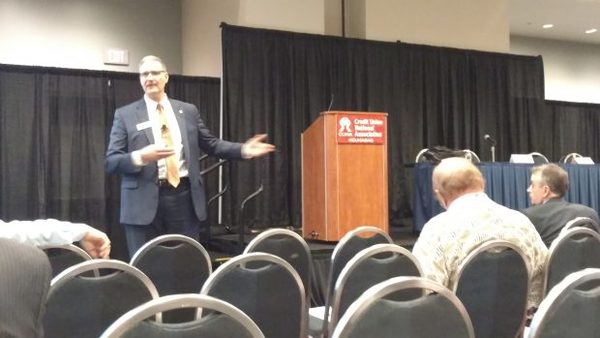 Michael Schenk, CUNA’s vice president of research policy and analysis
Michael Schenk, CUNA’s vice president of research policy and analysisWASHINGTON — Credit unions should see another year of double digit loan growth because the unemployment rate is expected to remain low and inflation is expected to remain tame through the rest of this year and into 2019, said Mike Schenk, CUNA’s vice president of research and policy analysis.
Since 2014, credit unions have seen annual loan growth of 10%, although small credit unions have not.
And while the economy is humming along, it hasn’t been good news for all consumers.
“We won’t see a huge increase in inflation being driven by low levels of unemployment and rising wages,” Schenk said during the GAC’s Economic Outlook break out session Monday. “The way to get at that is that we look at the difference between the 10-year Treasury yield minus the TIPS (treasury inflation protected securities) yield, and that is suggesting at the moment that over the next 10 years people that are buying and selling securities essentially believe that the inflation rate will average 2.1%.”
Additional economic data does not forecast an economic recession because the yield curve is not inverted. The yield curve is the difference between yields based on their maturity, which includes the short term fed funds interest rate and the longer term 10-year Treasury interest rate. An inverted yield curve means investors expect slow economic growth, low inflation and interest rate cuts.
“The yield curve for a while has been narrowing, but at the moment shows that there’s been a widening out of the yield curve, which suggests to us that more than likely at the moment the risk of recession is quite low,” he said. “By the way, yield curves don’t happen and then there’s a recession right away. Typically, there is a 12 to 18 month lag.”
What’s more, the recent fiscal stimulus from the tax cuts and the possibility of new public infrastructure investments should provide some tailwinds for the economy.
Despite the strong economy, however, it isn’t benefitting all consumers, noted Jordan van Rijn, CUNA’s senior economist.
“The economy is doing well, but as you guys might see among your members, they aren’t always doing so great,” van Rijn said.
Based on the Federal Reserve’s representative survey of economic well-being among American households, 44% of households could not cover a $400 emergency expense. Most households would have to pay for the emergency expense with a credit card, borrow from friends or family members, and 27% of households said they would have no way of covering that emergency expense.
Moreover, nearly 57% of household said that if they lost their main source of income, they could not cover their expenses for three months even if they used all of their savings, borrowed money or sold assets.
Although 70% of households said they were living comfortably and making ends meets, 30% of households reported it is difficult getting by or they are just getting by.
For every $100 they earn, Americans are only saving about $2.40, van Rijn said.
“This (savings rate) is the lowest it’s been since 2005 well before the recession, so this savings rate at this very low level also is an indication that people might be a little overleveraged, have very little savings,” van Rijn said. “It’s possible this comes up a little bit especially with the tax cuts and people getting their tax refund.”
Additionally, 22% of households are juggling two or more jobs and 28% have not retirement or pension plans.


